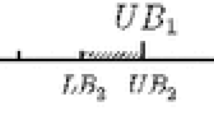Abstract
We consider a single-machine scheduling problem with multiple unavailability periods such that the processing time of each job is inversely proportional to the kth power of its own resource consumption amount. The objective is to minimize the sum of the makespan and the total resource consumption cost. For every \(k>0\), we show that the problem with one unavailability period is NP-hard while it admits a fully polynomial-time approximation scheme. Furthermore, we analyze the (in)approximability for the case with multiple unavailability periods. For every \(k>0\), we show that the problem with an arbitrary number of unavailability periods is strongly NP-hard. Finally, we extend the results to the problem of minimizing the makespan with a constraint on the total resource consumption cost.
Similar content being viewed by others
References
Cheng, T. C. E., & Janiak, A. (2000). A permutation flow-shop scheduling problem with convex models of operation processing times. Annals of Operations Research, 96, 39–60.
Choi, B.-C., & Park, M.-J. (2021) Two-machine flow shop scheduling with convex resource consumption functions, Optimization Letters.
Garey, M. R. (1979) A guide to the theory of NP-completeness. Computers and Intractability.
Janiak, A. (1989). Minimization of resource consumption under a given deadline in the two-processor flop-shop scheduling problem. Information Processing Letters, 32, 101–112.
Janiak, A., Janiak, W., & Lichtenstein, M. (2007). Resource management in machine scheduling problems: A survey. Decision Making in Manufacturing and Services, 1, 59–89.
Ma, Y., Chu, C. B., & Zuo, C. R. (2010). A survey of scheduling with determinisitc machine availability constraints. Computers & Industrial Engineering, 58, 199–211.
Monma, C. L., Schrijver, A., Todd, M. J., & Wei, V. (1990). Convex resource allocation problems on directed acyclic graphs: Duality, complexity, special cases, and extensions. Mathematics of Operations Research, 15, 736–748.
Sanlaville, E., & Schmidt, G. (1998). Machine scheduilng with availability contraints. Acta Informatica, 35, 795–811.
Schmidt, G. (1988). Scheduling independent tasks with deadlines on semi-identical processors. Journal of the Operational Research Society, 39, 271–277.
Schmidt, G. (2000). Scheduling with limited machine availability. European Journal of Operational Research, 121, 1–15.
Shabtay, D. (2021). Single-machine scheduling with machine unvailability periods and reource dependent processing times. European Journal of Operational Research. https://doi.org/10.1016/j.ejor.2021.03.034.
Shabtay, D., & Kaspi, M. (2004). Minimizing the total weighted flow time in a single machine with controllable processing times. Computers and Operations Research, 31, 2279–2289.
Shabtay, D., & Kaspi, M. (2006). Parallel machine scheduling with a convex resource consumption function. European Journal of Operational Research, 173, 92–107.
Shabtay, D., & Steiner, G. (2007). A survey on scheduling with controllable processing times. Discrete Applied Mathematics, 155, 1643–1666.
Shabtay, D., Kaspi, M., & Steiner, G. (2007). The no-wait two-machine flow shop scheduling problem with convex resource-dependent processing times. IIE Transactions, 39, 539–557.
Shabtay, D., & Zofi, M. (2018). Single machine scheduling with controllable processing times and an unavailablity period to minimize the makespan. International Journal of Production Economics, 198, 191–200.
Vickson, R. G. (1980). Choosing the job sequence and processing times to minimize total processing plus flow cost on a single machine. Operations Research, 28, 1155–1167.
Acknowledgements
This work was supported by the Ministry of Education of the Republic of Korea and the National Research Foundation of Korea (NRF-2021S1A5B8096365).
Author information
Authors and Affiliations
Corresponding author
Additional information
Publisher's Note
Springer Nature remains neutral with regard to jurisdictional claims in published maps and institutional affiliations.
Appendix A. Proof of Lemma 1
Appendix A. Proof of Lemma 1
Proof
For \(i<l\), the jobs in \({\mathcal {J}}_i\) contribute \(\sum _{j \in {\mathcal {J}}_i} c_j u_j\) in \(z_{1}(\sigma )\) by (4). Hence, the optimal resource allocation problem for jobs in \({\mathcal {J}}_i\) can be written as follows:
Shabtay and Zofi (2018) showed that \(\sum _{j \in {\mathcal {J}}_i} p_j(u_j) = L_i\) and (8) hold in problem (31).
The jobs in \({\mathcal {J}}_l\) contribute \(\sum _{j \in {\mathcal {J}}_l} t_j(u_j)\) in \(z_{1}(\sigma )\) by (4). Hence, the optimal resource allocation problem for jobs in \({\mathcal {J}}_l\) can be written as follows:
If \(s_l \le L_l\), then the optimal solution exists at \(u_j = \tau _j\) for \(j \in {\mathcal {J}}_l\) by (7). Henceforth, we focus on the case with \(s_l > L_l\). If \(\sum _{j \in {\mathcal {J}}_l} p_j(u_j) < L_l\), then a job \(j \in {\mathcal {J}}_l\) exists with \(u_j> \tau _j\). Since \(t_j(u_j)\) is an increasing function for \(u_j > \tau _j\), however, we can decrease the objective value without violating the feasibility by decreasing \(u_j\) by a sufficiently small value. This implies that \(\sum _{j \in {\mathcal {J}}_l} p_j(u_j) = L_l\) in the optimal solution for problem (32). Then, the objective function can be represented as \((L_l + \sum _{j \in {\mathcal {J}}_l} c_j u_j)\), which implies that problem (32) is reduced to problem (31). Thus, the optimal solution for problem (32) can be represented by (9). \(\square \)
Rights and permissions
About this article
Cite this article
Choi, BC., Park, MJ. Single-machine scheduling with resource-dependent processing times and multiple unavailability periods. J Sched 25, 191–202 (2022). https://doi.org/10.1007/s10951-022-00723-z
Accepted:
Published:
Issue Date:
DOI: https://doi.org/10.1007/s10951-022-00723-z




